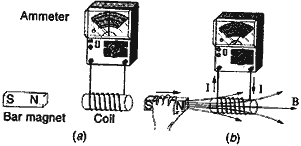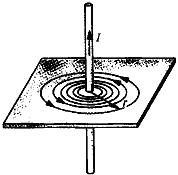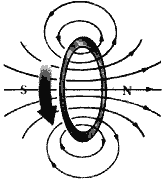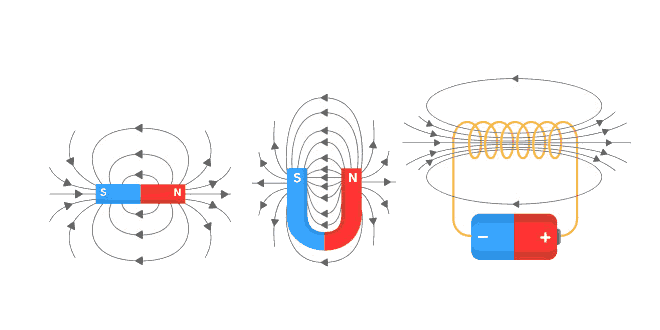Question: State the rule to determine the direction of magnetic field produced around a current carrying produced around a current carrying conductor.
Answer: Imagine a current carrying conductor held in your right hand such that the thumb points in the direction of current, then the curl of your fingers encircling the conductor will give the direction of magnetic field lines around the conductor.
Question: What is meant by the term “magnetic field lines”?
Answer: A magnetic field line is a path which will be followed by a “hypothetical” north pole in the magnetic field of another magnet if it is allowed to move freely. Two properties on magnetic field lines are:
- Two magnetic field lines do not intersect each other.
- They travel from the north to the south pole of a magnet outside the magnet and from South to the North Pole inside the magnet.
Question: With the help of a neat diagram, describe how you can generate induced current in a circuit.
Answer: The figure below shows a bar magnet and a helical coil of wire to which a galvanometer is connected. When there is no relative motion between the bar magnet and the coil, as in part (a) of the figure, the galvanometer reads zero, indicating there is no current. However, when the magnet moves toward the coil, as in part (b), a current appears in the coil. As the magnet approaches, the magnetic field that it creates at the location of the coil becomes stronger and stronger, and it is this changing magnetic field that produces the current. When the magnet moves away from the coil a current also axists, but the direction field at the coil becomes weaker as the magnet moves away. Once again, it is the changing magnetic field at the coil that generates the current.

Question: Why is series arrangement not used for domestic circuits?
Answer: In domestic circuits series arrangement is not used because of the following reasons:
- The total potential difference available (usually 220 volts) is divided between various appliances in the circuit according to their resistances since the current flowing through all the appliances is the same. Thus, each appliance will not get the required potential difference for it to operate properly.
- if one of the appliances is out of order, e.g., if a bulb gets fused, all the appliances in the circuit will stop working as the circuit gets broken.
- All the appliances will work simulta-neously whether we want them to work or not, thereby involving a lot of power wastage.
- If we switch of any of the appliances, the circuit is broken and all the appliances will stop working.
Question: Explain what is short-circuiting and overloading in an electric supply.
Answer: Short-circuiting takes place when the live and neutral wires come in direct contact with each other. The live (positive) wire and the neutral (negative) wire come in direct contact with each other. This happens due to (i) damage to the insulation of the power-lines (ii) a fault in an electric appliance due to which current does not pass through it. On account of short-circuiting, resistance of the circuit decreases to a vary small value and consequently the current becomes vary large. This large current results in heating of live wires which produces sparking at the point of short-circuiting. This sparking sometimes causes fire in a building.
An electric circuit is said to be overloaded if all the electric appliances in the circuit draw more current than the permitted limit. Overloading results in excessive heating.
Question: State the characteristic of magnetic force.
Answer: The following are the characteristics of magnetic force:
- Magnetic force acts only on moving charges and not on stationary charges.
- No magnetic force acts on a charge if it is moving along the direction of the magnetic field.
- The direction of magnetic force is perpendicular to (a) the direction velocity of the charge and (b) the direction of the magnetic field.
- The magnetic force (F) depends on the charge (q), velocity (v) and the strength (B) of the magnetic field, i.e., F = q v B (in case the direction of v is perpendicular to the direction of B)
- The magnetic force (F) acting on a current carrying conductor placed perpendicular to the direction of magnetic field (B) is given by F = BIL, where I is the current flowing in the conductor, L is its length in the magnetic field.
Question: The flow of a current in a circular loop of a wire creates a magnetic field at its centre. How can existence a magnetic field at its centre. How can existence of this field be detected? State the rule which help to predict the direction of this magnetic field.
Answer: Bend a wire in the shape of a circular loop. Pass the coil through a cardboard. connect the free ends of the coil to a battery and a key. Sprinkle some iron filings on the cardboard. Put on the key you will find that the iron filing arrange themselves in the form of concentric circles. The magnetic lines of forces near each segment of wire are circular and form concentric circles, wheres the lines of force near the centre of the coil are almost straight lines.
The right hand thumb rule predicts the direction of this magnetic field it states “Grasp the conductor in the right hand with the thumb pointing in the direction of current, and then the direction in which the fingers curl gives the direction of the magnetic field.”
Question: How does the strength of the magnetic field at the centre of a circular coil of wire depend on: (1) the radius of the coil (2) the number of turns of wire in the coil (3) the strength of the current flowing in the coil?
Answer: The magnetic field is:
- Inversely proportional to the radius of the coil.
- Directly proportional to the number of turns in the coil.
- Directly proportional to the current flowing through the coil.
Question: Draw the pattern of line of force due to a magnetic field associated with a current carrying conductor. State how the magnetic field product changes (1) with an increase i current in the conductor and (2). the distance from the conductor.
Answer: The pattern of line is as shown below:

- The magnetic field increases with an increase in current.
- The magnetic field decreases with an increase in distance from the conductor.
Question: Draw the pattern of lines of force due to a magnetic field through and around a current carrying loop of wire. How would the strength of the magnetic field produced at the center of the circular loop be affected if (1). the strength of the current passing through this loop is doubled? (ii) the radius of the loop is reduced to half of the original radius?
Answer: The pattern of line is as shown:

- The magnetic field strength is doubled as B ∝ I.
- The magnetic field strength is doubled as B ∝ 1/r.
Question: Why do iron filing arrange themselves in a certain pattern around a magnet?
Answer: The magnetic exerts its influence in the region surrounding it. Therefore, the iron filings experience a force. The force thus exerted makes the iron filings arrange in a pattern.
Question: How is the relative strength of a magnetic field shown around a magnet?
Answer: The relative strength of the magnetic field is shown by the degree of closeness of the field lines. The field is stronger, that is, the force acting on the pole of another magnet placed is greater where the field lines are crowded.
Question: A current through a horizontal power line flows in east to west direction. What is the direction of magnetic field at a point directly below it and a point directly above it?
Answer: The current is in the east west direction. Applying the right hand thumb rule, we get that the direction of magnetic field at a point below the wire is from north to south. The direction of a magnetic field at a point directly above the wire is from south to north.
Question: Two long parallel wires are hanging freely. If they are connected to a battery (1) in series and (2) in parallel, what would be the effect on their positions?
Answer:
- In series: The current flowing in them will be in the opposite direction. Hence, they will repel each other.
- In parallel: The current flowing in them will be in the same direction. Hence, they will attract other.
 Class Notes NCERT Solutions for CBSE Students
Class Notes NCERT Solutions for CBSE Students





